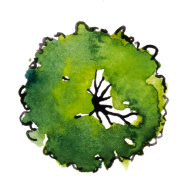The Gardener's Journal
MARVELOUS MOSS

On our family hikes, our little granddaughters are fascinated by the varied textures, colors, and appearances of the mosses we find along the trails. We like moss so much that we now enjoy it daily in our own garden! In addition to its sensory beauty, I am discovering that moss is noteworthy (and valued) for a number of interesting reasons:
– There are close to 10,000 species of moss which can be found on all seven continents, even in ice-covered Antarctica.
– Although most commonly seen in moist, shady locations, some species of moss are found in deserts.
– Many species of moss draw moisture from the air through leaves, rather than through roots. Desert mosses use tiny, pointed mechanisms on the leaf tips to gather any hint of humidity from the surrounding air.
– In the past, native tribes across the globe used moss to line skin or fur underwear in lieu of disposable diapers for their little ones. Because moss can absorb 20 times its weight in liquid and is disposable, “it was the perfect choice for ancient tribal parents on the go,” writes Bruce Maisy (in Ranker; see website below).
– Ancient people groups also used moss to cleanse and heal wounds. As recently as WWI, surgeons resorted to moss when cotton was in short supply. Apparently, Europe and America produced millions of moss bandages to treat their wounded over the course of the war, taking advantage of peat moss’s absorbency and antiseptic qualities.
– In Japan, moss is a highly-prized garden feature. In fact, Saihoj-ji, Kyoto’s famous 35,000square-meter moss garden, features 120 species of moss and is a UNESCO World Heritage site. Japan’s continuing love affair with moss is now evidenced by moss-themed drinks and jewelry.
Shared by Betty Hansleman
Gardener’s wife (& moss enthusiast)
Interesting facts credited to: https://www.ranker.com/list/amazing-moss-facts/bruce-maisy?fbclid=IwAR1LFOlKJgvC8QryjMjA0akG1_PAgqekOCdscxeNjFXzx7SHFvMlqpSZLEQ
OUR GARDEN DESIGN PROCESS

Explore
Share your goals, ideas, and project budget and we will begin to survey and plan your garden

Design
We will consider all your primary view perspectives, both inside and out as we design your garden

Build
Your garden dream will begin to take shape by the hands of our highly skilled craftsmen and landscapers

Enjoy
Your garden dream will begin to take shape by the hands of our highly skilled craftsmen and landscapers



